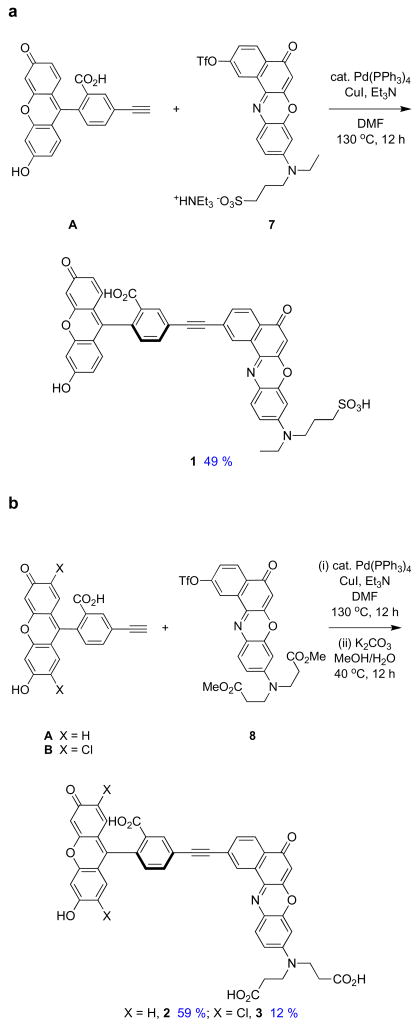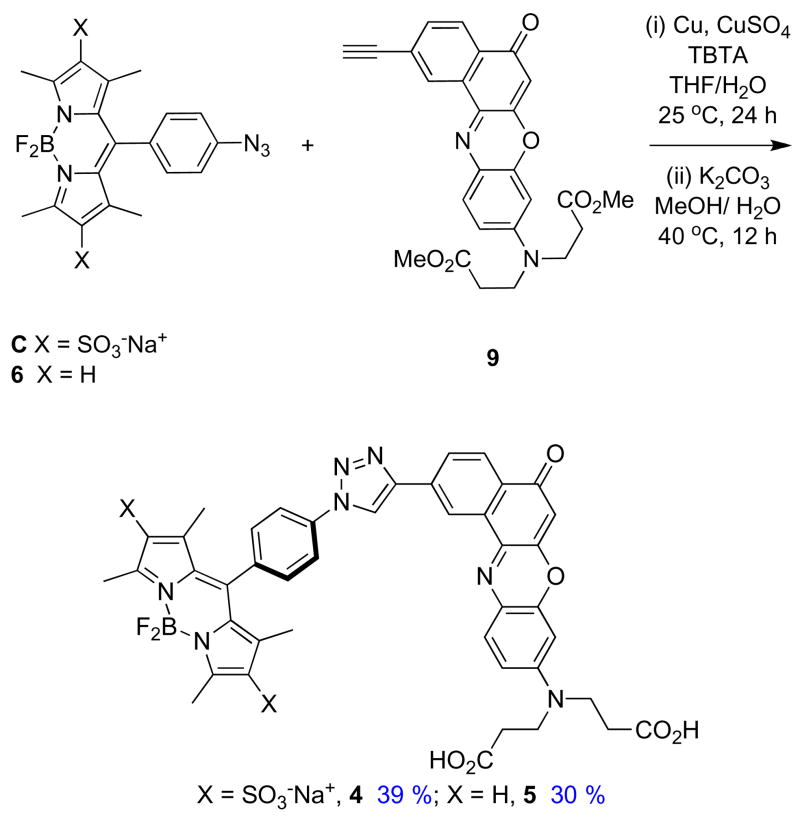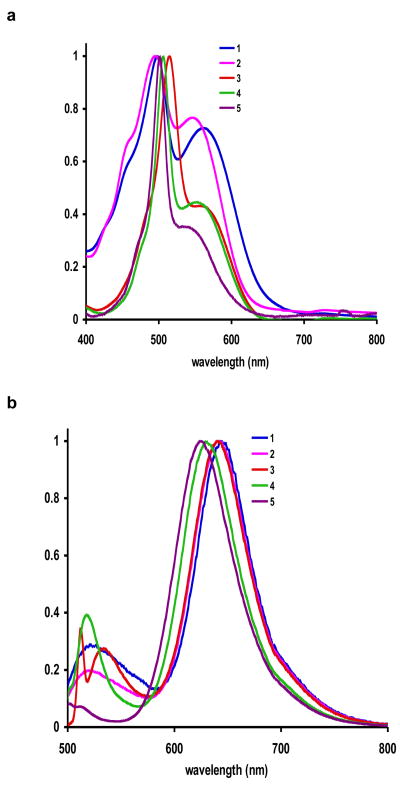Abstract
This project was initiated to develop energy transfer dyads emitting in the 600 – 700 nm region by using Nile Red acceptors. Thus fluorescein- and BODIPY-based donors were linked to these acceptors via alkynes or triazoles. The product dyads (1 – 5) have energy transfer efficiencies of 77 – 97% in organic media.
Keywords: fluorophores, microwave reactions, Sonogashira coupling
Through-bond energy transfer is possible in molecules containing two fluorophores connected in such a way that they would be electronically conjugated if they were planar.1–6 Our group is interested in the applications of such dyads in biotechnology,7,8 especially for multiplexing experiments in which several outputs are to be observed from a single excitation source.9,10 Nile Red is a solvatochromic dye with solvent dependent emissions. In polar media Nile Red derivatives have emissions in the 630 – 650 nm region. Outputs at such wavelengths, ie longer than cellular autofluorescence,11 are highly desirable for cellular probes, so dyads containing Nile Red are logical targets, but they have not been described in the literature. Here we report the syntheses and photophysical properties of dyads 1 – 5.
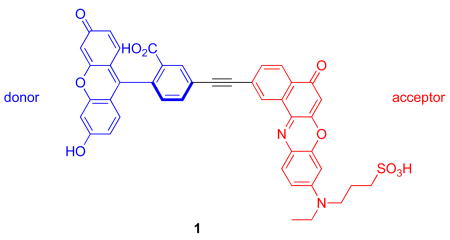
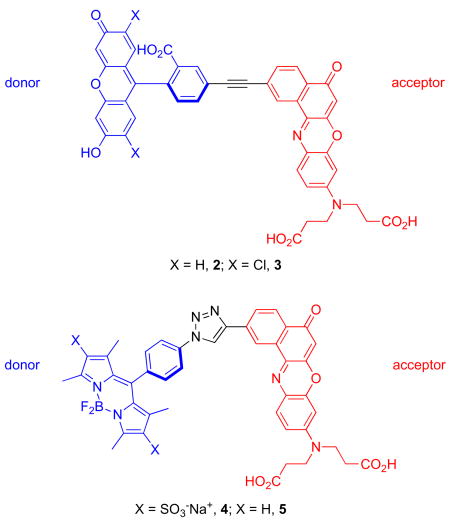
Dyads 1 – 3 have fluorescein-based donors, while BODIPY derivatives perform this role in 4 and 5. Three of the donor fragments A – C were prepared via methods already developed in this laboratory (Figure 2).12–14 The other donor, the BODIPY derivative 6, was synthesized from the nitro compound D15 via reduction with hydrazine.13 The amine product is unstable hence it was immediately diazotized then treated with azide anion (reaction 1).
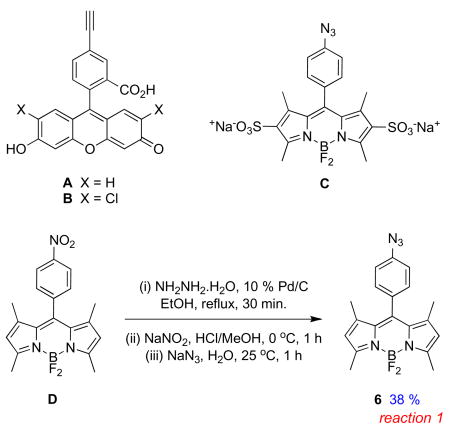
Water-solubilities are important since the long-term goals of this research are to prepare probes that can be used in biological environments. Consistent with this idea, donors A C are very hydrophilic. Nile Red acceptors that also tend to improve water solubilities were available from previous work by others16 and by us.17 Compounds in this series typically fluoresce with quantum yields around 0.4 in EtOH and 0.3 in pH 7.4 phosphate buffer.17,18 Thus, the sulfonate 7 was made via triflation {PhN(Tf)2, NEt3, THF, 25 °C, 24 h}19 of the corresponding 2-hydroxy Nile Red derivative,16 and a similar reaction followed by Sonogashira coupling20 (of trimethylsilylethyne, then TBAF deprotection) gave derivatives 8 and 9.
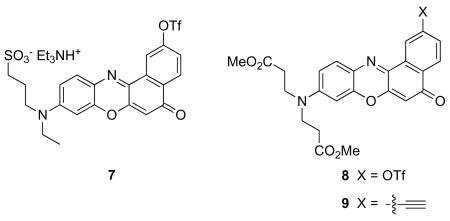
Scheme 1 outlines syntheses of the alkyne-linked dyads 1 – 3. The coupling reactions proceeded only above 100 °C, and 130 °C was preferred. The dichlorofluorescein alkyne B is not very stable at 130 °C hence the coupling reaction using this was low yielding. Throughout, Pd(PPh3)4 was an effective catalyst while Cl2Pd(PPh3)2 did not give any significant amount of product.
Scheme 1.
Syntheses of the alkyne linked dyads 1 – 3.
Dyads 4 and 5 were synthesized via copper catalyzed 1,3-dipolar cycloadditions using tris(1 - benzyl - 1H - 1,2,3 - triazol - 4 - yl)methyl amine (TBTA) ligand21 as a copper stabilizer (Scheme 2) without which the yields were poor. Reaction of the water-soluble BODIPY-azide C with the Nile Red alkyne 9, followed by hydrolysis in aqueous methanolic K2CO3 afforded cassette 4 as a dark purple material. The low yields obtained for these two dyads are probably due to the apparent instability of BODIPY fragments in basic aqueous media.
Scheme 2.
Synthesis of dyads 4 and 5.
Absorption and emission profiles of dyads 1 – 5 in EtOH are shown in Figure 1. As expected, two distinct absorption maxima were observed in each case corresponding to the donor and acceptor fragments. Their fluorescence spectra show efficient energy transfer without significant —leakage of emission from the donor fragment. The prominent emissions from all the dyads derive from the acceptor fragment with comparatively less emission from the donor parts. Their quantum efficiencies when excited at the donor absorption maxima, were determined to be in the range of 0.31 – 0.41. The energy transfer efficiency (ETE %, quantum yield of cassette when excited at the donor divided by that when excited at the acceptor)10 was calculated to be 77 – 97 % (Table 1). The later parameter is less informative, because it does not take into account energy lost in other processes. The apparent Stokes’ shifts for the dyads ranged from 120 to 150 nm. Much less efficient energy transfer was observed for the dyads in aqueous buffer, but the large Stokes’ shifts persisted (see supplementary).
Figure 1.
Normalized absorbance (a) and fluorescence (b) spectra of dyads 1 – 5 in EtOH (at 10−6 and 10−7 M for absorbance and fluorescence measurements, respectively). All dyads excited at their respective donor absorption maxima.
Table 1.
Photophysical properties of dyads 1 – 5 in EtOH.
| dye | λabs(nm) | λem.(nm) | Stokes Shift (nm) | ΦD | ΦAc | ETE % (ΦD/ΦA) |
|---|---|---|---|---|---|---|
| 1 | 498, 561 | 648 | 150 | 0.31+/− 0.02a |
0.40+/− 0.03 |
77 |
| 2 | 495, 546 | 644 | 149 | 0.34+/− 0.01a |
0.38+/− 0.01 |
89 |
| 3 | 515, 555 | 645 | 130 | 0.36+/− 0.03b |
0.43+/− 0.02 |
83 |
| 4 | 506, 553 | 632 | 126 | 0.41+/− 0.02b |
0.49+/− 0.02 |
81 |
| 5 | 501, 541 | 624 | 123 | 0.36+/− 0.02b |
0.37+/− 0.01 |
97 |
ΦD values correspond to excitation of dyads at the donor absorption maxima; ΦA relates to excitation of dyads at the acceptor absorption maxima. Standards used for the quantum yield measurements:
fluorescein in 0.1 M NaOH (Φ0.92),
rhodamine 6G in EtOH (Φ0.94),
rhodamine 101 in EtOH (Φ1.0). Quantum yield measurements were repeated three times and averaged.
In conclusion we have prepared five dyads based on Nile Red acceptors and fluorescein or BODIPY fragments as donors. These show efficient energy transfer in ethanol and fluoresce with a quantum yield of 0.31–0.41. Their long wavelength emission and large Stokes’ shifts are useful for fluorescence studies in polar, hydrogen-bonding, organic solvents. Our current efforts are focused on making similar dyads with improved photophysical properties for use in biological media.
Supplementary Material
Acknowledgments
We thank Dr Mike Collins and CEM Corporation for support with microwave technologies. Dr Shane Tichy and the TAMU/LBMS-Applications Laboratory are acknowledged. Financial support was provided by The NIH (GM 72041) and by The Robert A. Welch Foundation.
Footnotes
Synthetic procedures for all compounds, copies of 1H, 13C NMR spectra.
Publisher's Disclaimer: This is a PDF file of an unedited manuscript that has been accepted for publication. As a service to our customers we are providing this early version of the manuscript. The manuscript will undergo copyediting, typesetting, and review of the resulting proof before it is published in its final citable form. Please note that during the production process errors may be discovered which could affect the content, and all legal disclaimers that apply to the journal pertain.
References
- 1.Lammi RK, Ambroise A, Balasubramanian T, Wagner RW, Bocian DF, Holten D, Lindsey JS. J Am Chem Soc. 2000;122:7579–91. [Google Scholar]
- 2.Muthiah C, Kee HL, Diers JR, Fan D, Ptaszek M, Bocian DF, Holten D, Lindsey JS. Photochem Photobiol. 2008;84:786–801. doi: 10.1111/j.1751-1097.2007.00258.x. [DOI] [PubMed] [Google Scholar]
- 3.Skene WG, Dufresne S. Org Lett. 2004;6:2949–52. doi: 10.1021/ol048977m. [DOI] [PubMed] [Google Scholar]
- 4.Ambroise A, Wagner RW, Rao PD, Riggs JA, Hascoat P, Diers JR, Seth J, Lammi RK, Bocian DF, Holten D, Lindsey JS. Chem Mater. 2001;13:1023–34. [Google Scholar]
- 5.Otsuki J, Kanazawa Y, Kaito A, Islam DMS, Araki Y, Ito O. Chem--Eur J. 2008;14:3776–84. doi: 10.1002/chem.200701486. [DOI] [PubMed] [Google Scholar]
- 6.Anzenbacher P, Jr, Palacios MA. Nat Chem. 2009;1:80–6. S/1–S/10. doi: 10.1038/nchem.125. [DOI] [PubMed] [Google Scholar]
- 7.Burgess K, Gibbs R. 2002 U.S. Patent 6340750. [Google Scholar]
- 8.Burgess K. 2005 U.S. Patent 7402677. [Google Scholar]
- 9.Jiao G-S, Thoresen Lars H, Burgess K. J Am Chem Soc. 2003;125:14668–9. doi: 10.1021/ja037193l. [DOI] [PubMed] [Google Scholar]
- 10.Wu L, Loudet A, Barhoumi R, Burghardt RC, Burgess K. J Am Chem Soc. 2009;131:9156–7. doi: 10.1021/ja9029413. [DOI] [PMC free article] [PubMed] [Google Scholar]
- 11.Frangioni JV. Curr Opin Chem Biol. 2003;7:626–34. doi: 10.1016/j.cbpa.2003.08.007. [DOI] [PubMed] [Google Scholar]
- 12.Thoresen LH, Jiao GS, Haaland WC, Metzker ML, Burgess K. Chem Eur J. 2003;9:4603–10. doi: 10.1002/chem.200304944. [DOI] [PubMed] [Google Scholar]
- 13.Li L, Han J, Nguyen B, Burgess K. J Org Chem. 2008;73:1963–70. doi: 10.1021/jo702463f. [DOI] [PubMed] [Google Scholar]
- 14.Burgess K, Castro JC, Malakhov A. Synthesis. 2008;7:1224–6. [Google Scholar]
- 15.Ueno T, Urano Y, Kojima H, Nagano T. J Am Chem Soc. 2006;128:10640–1. doi: 10.1021/ja061972v. [DOI] [PubMed] [Google Scholar]
- 16.Briggs MSJ, Bruce I, Miller JN, Moody CJ, Simmonds AC, Swann E. J Chem Soc, Perkin Trans 1. 1997;7:1051–8. [Google Scholar]
- 17.Jose J, Burgess K. Tetrahedron. 2006;62:11021–37. [Google Scholar]
- 18.Jose J, Burgess K. J Org Chem. 2006;71:7835–9. doi: 10.1021/jo061369v. [DOI] [PubMed] [Google Scholar]
- 19.Okamoto A, Tainaka K, Fujiwara Y. J Org Chem. 2006;71:3592–8. doi: 10.1021/jo060168o. [DOI] [PubMed] [Google Scholar]
- 20.Sonogashira K, Tohda Y, Hagihara N. Tetrahedron Lett. 1975;16:4467–70. [Google Scholar]
- 21.Chan TR, Hilgraf R, Sharpless KB, Fokin VV. Org Lett. 2004;6:2853–5. doi: 10.1021/ol0493094. [DOI] [PubMed] [Google Scholar]
Associated Data
This section collects any data citations, data availability statements, or supplementary materials included in this article.



